“Amicus does not lightly make this comparison between internal operations of the PTAB and the former Soviet Union’s depraved system of justice. However, the GAO Report permits no lesser conclusion.” – US Inventor brief
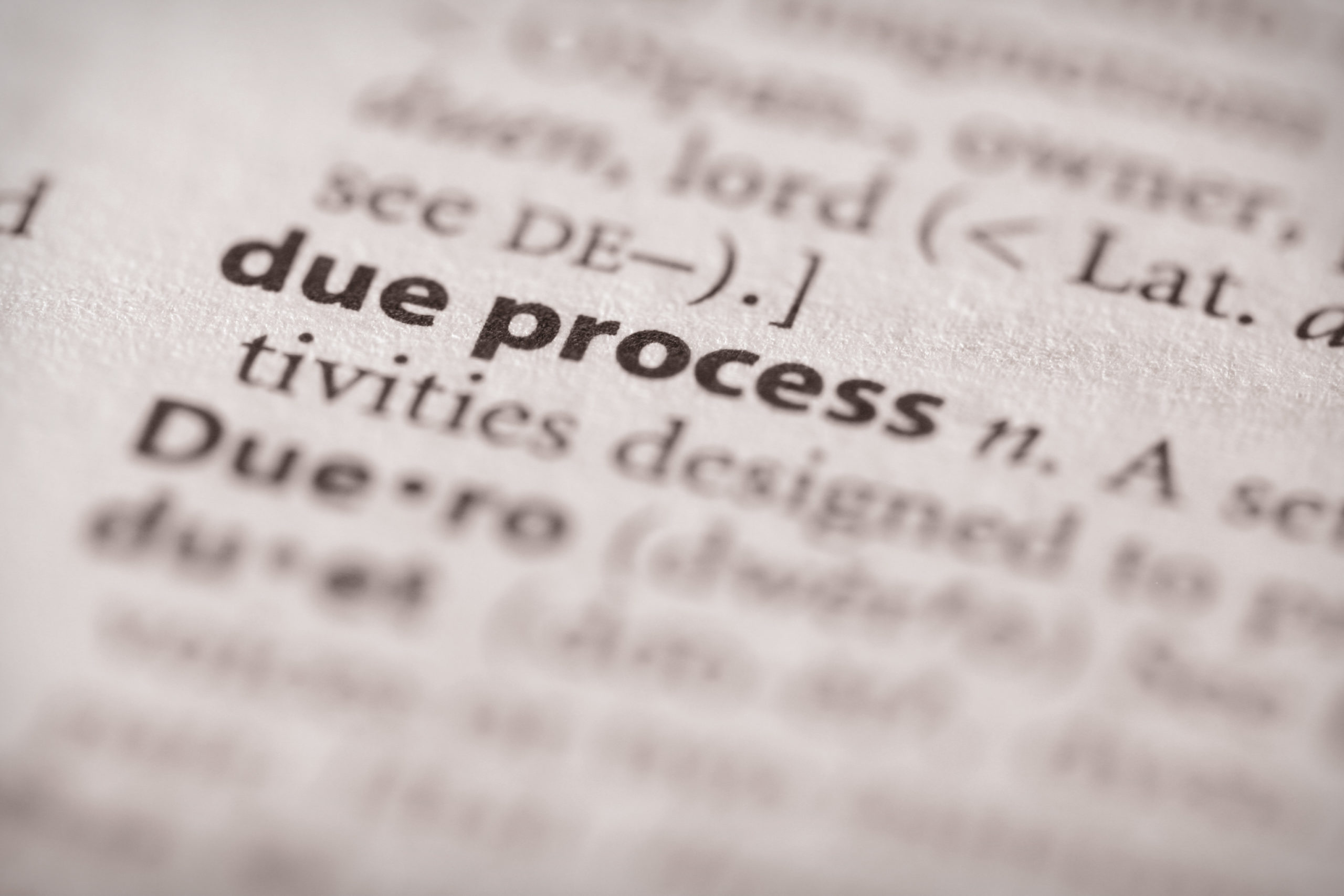 Inventor organization US Inventor (USI) and Ron Katznelson—the author of a widely cited study detailing the link between Patent Trial and Appeal Board (PTAB) judges’ decisions and their compensation—have filed separate amicus briefs supporting New Vision Gaming and Development, Inc. in its most recent appeal to the U.S. Court of Appeals for the Federal Circuit (CAFC). New Vision is arguing that America Invents Act (AIA) trials violate the Due Process Clause and that the recent Government Accountability Office (GAO) Report documenting how U.S. Patent and Trademark Office (USPTO) and PTAB management control influences Administrative Patent Judges’ (APJ) decision making bolsters its previous arguments and warrants a new appeal. While USI’s brief expands upon this argument, Katznelson’s provides both old and new data that he says proves a “structural bias” exists.
Inventor organization US Inventor (USI) and Ron Katznelson—the author of a widely cited study detailing the link between Patent Trial and Appeal Board (PTAB) judges’ decisions and their compensation—have filed separate amicus briefs supporting New Vision Gaming and Development, Inc. in its most recent appeal to the U.S. Court of Appeals for the Federal Circuit (CAFC). New Vision is arguing that America Invents Act (AIA) trials violate the Due Process Clause and that the recent Government Accountability Office (GAO) Report documenting how U.S. Patent and Trademark Office (USPTO) and PTAB management control influences Administrative Patent Judges’ (APJ) decision making bolsters its previous arguments and warrants a new appeal. While USI’s brief expands upon this argument, Katznelson’s provides both old and new data that he says proves a “structural bias” exists.
New Vision filed a brief with the CAFC on September 6, on return from remand after the USPTO denied its request for Director Review. The case relates to a PTAB decision canceling all claims of U.S. Patent No. 7,325,806 (‘806 patent) and was previously appealed to the CAFC. But since the last appeal, the GAO released a preliminary report revealing that PTAB judges are influenced by USPTO leadership, giving new weight to New Vision’s arguments.
We Should Be Eschewing Soviet-Style ‘Telephone Justice’
US Inventor filed an amicus brief on September 12 arguing that “all litigants (petitioners and patent owners) have endured a [PTAB] system that, since inception, betrayed American ideals of impartial and unbiased judicial decision making.” The brief further claims that the GAO’s “bombshell report” bolsters New Vision’s due process case, revealing that “APJs are subject to PTO and PTAB oversight and interference, such as Management Review and ARC, that lead to changed AIA outcomes.”
The House Judiciary Committee’s Subcommittee on Courts, Intellectual Property, and the Internet in July held Part II in a series of hearings to consider reforms to the PTAB 10 years after it was created by the AIA. The hearing coincided with the release of a preliminary report by the GAO that was commissioned in June of last year by IP Subcommittee Chair Hank Johnson (D-GA) and Ranking Member Darrell Issa (R-CA) to investigate PTAB decision-making practices. The GAO’s preliminary findings revealed that “the majority of [administrative patent] judges (75 percent) surveyed by GAO responded that the oversight practiced by U.S. Patent and Trademark Office (USPTO) directors and PTAB management has affected their independence, with nearly a quarter citing a large effect on independence.”
USI’s brief cited to other circuit courts of appeal decisions underscoring the importance of judicial independence to American values and said that the situation revealed by the GAO report amounts to “telephone justice.” Using the example of Supreme Court Justice Breyer’s account of his visit with a convention of Russian judges just after Boris Yeltsin’s election, during which the party boss called the judges to tell them how to decide the outcome of a particular case, USI said the United States should abhor such behavior as contrary to the “rule of law” and the “foundation of freedom.” USI added:
Amicus does not lightly make this comparison between internal operations of the PTAB and the former Soviet Union’s depraved system of justice. However, the GAO Report permits no lesser conclusion. The GAO Report cites facts that show the PTAB broke the “universal rule against secret trials,” In re Oliver, 333 U.S. 257, 266 (1948), and contravened the principle that “the administration of justice cannot function in the dark.”
USI also said the Federal Circuit should grant New Vision’s appeal in order to obtain relief for the APJs themselves. “They each suffer their own harm from being tethered to employment that forbids their comportment with national and international norms of judicial conduct,” said the brief.
Finally, USI recalled its previous argument that a study it conducted “found that there is an ‘October Effect’ supporting New Vision Gaming’s due process arguments about financial incentives.” The October Effect refers to the phenomenon uncovered by the study in which “the first month of the performance review year has consistently revealed APJ panels stretching farther to grant less meritorious petitions than they do in the final month when their pipeline for the prior year’s “decisional units” is already full. PTAB APJs disproportionately institute trial on weaker petitions when their decisional counter has reset to zero.”
Decisional Unit Credits are Not ‘Fungible’
Katznelson’s amicus brief, filed yesterday, is based on his July 2021 study, titled “The Pecuniary Interests of PTAB Judges—Empirical Analysis Relating Bonus Awards to Decisions in AIA Trials” but also includes some new information. Katznelson’s study examined the features of the PTAB bonus plan and the relationship between the awards paid to APJs in fiscal year 2016 and the number and type of decisions they made that year. “Specifically, APJs are awarded Decisional Unit (DU) credits for the work done on decisions they make in adjudicating any ex parte appeal” or AIA trial, says the amicus brief. “The larger number of DU credits APJs receive, the easier it is for them to obtain larger bonus awards and improve their opportunity for a salary increase.” While the USPTO has argued that the DU credits are fungible and that APJs could work on the large backlog of ex parte appeals rather than instituting AIA trials if they wanted to, Katznelson claims this assertion is false:
“This Brief shows that this PTO proposition is false and that APJs do not only have the capability and substantial incentives to earn the same number of DUs by working significantly fewer hours through institution and work on AIA trials, but that they are also subject to other organizational impediments and may be forbidden from taking on additional ex parte appeal work. As such, APJ’s are manifestly subject to ‘structural bias’ to institute more AIA trials, in violation of the Due Process Clause.”
Next, using data published by the USPTO to support its “aggregate costs” to justify changes to user fees, Katznelson showed that there is “a consistent trend, wherein APJs worked fewer hours on AIA trials to earn the same amount of DU credits they would earn from working on ex parte appeals.” As detailed in his July 2021 study, the brief explained:
“[T]he top 20 APJ bonus earners were predominantly engaged in AIA trials, with the median of only 5.1% work share of decisions in ex parte appeals. In contrast, the bottom 20 bonus earners were predominantly engaged in ex parte appeal decisions, with a median of 54.2% share of decisions being ex parte appeal decisions.”
See Katznelson’s brief for more information about the charts below:
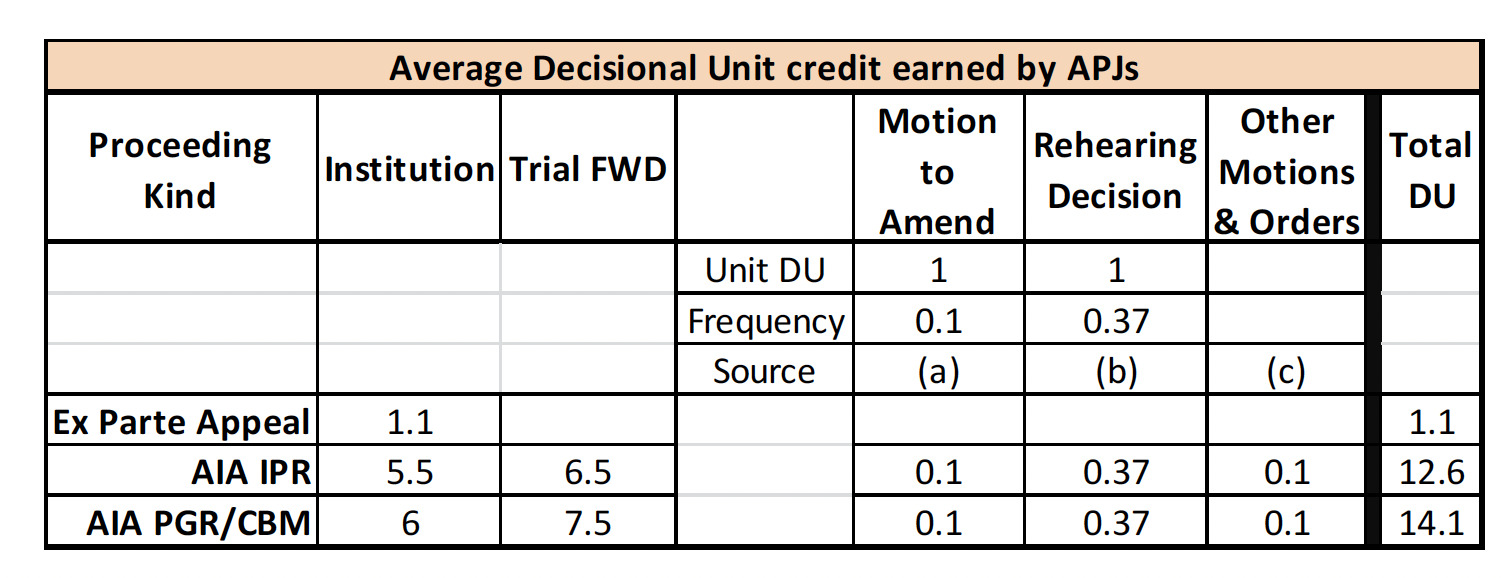
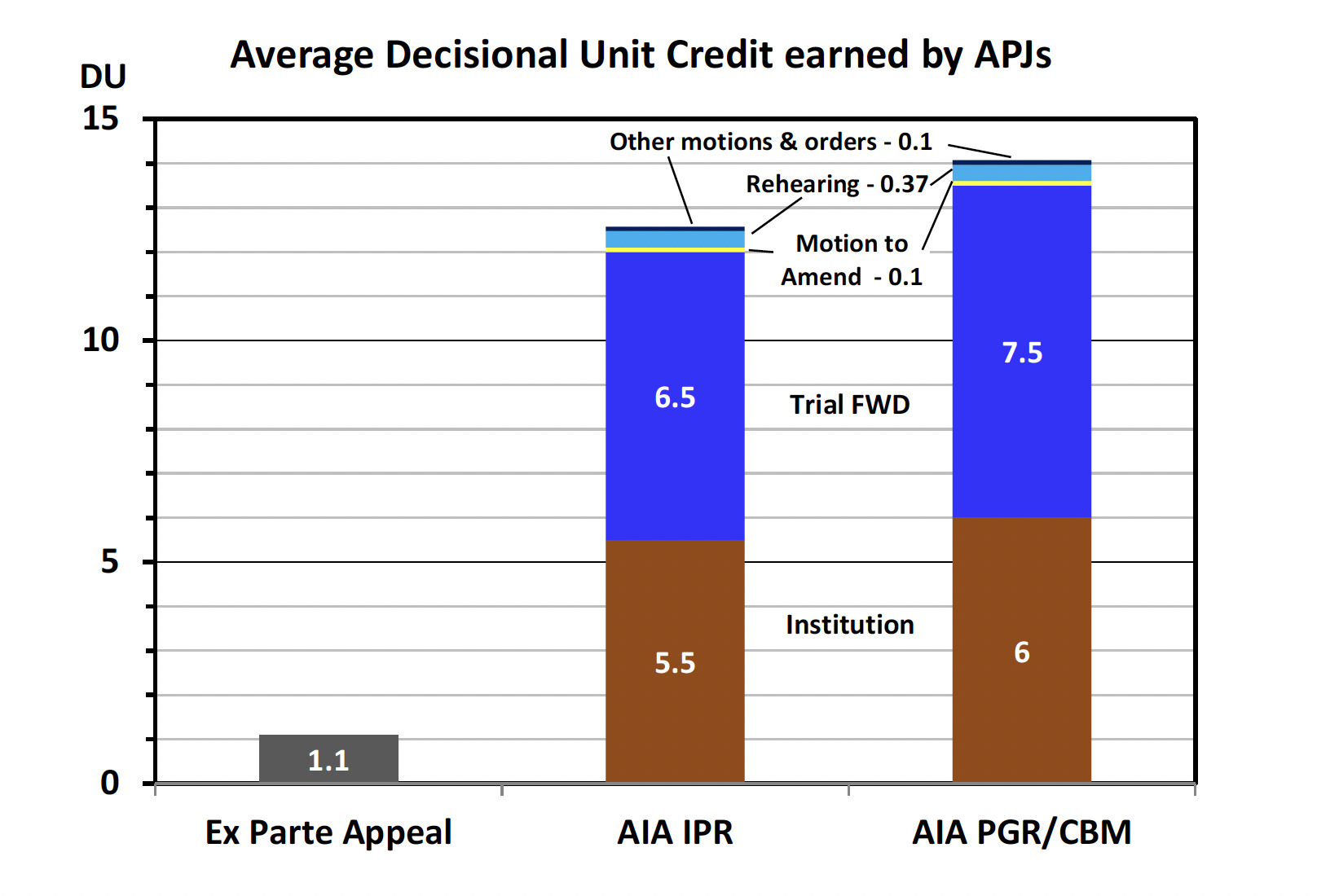
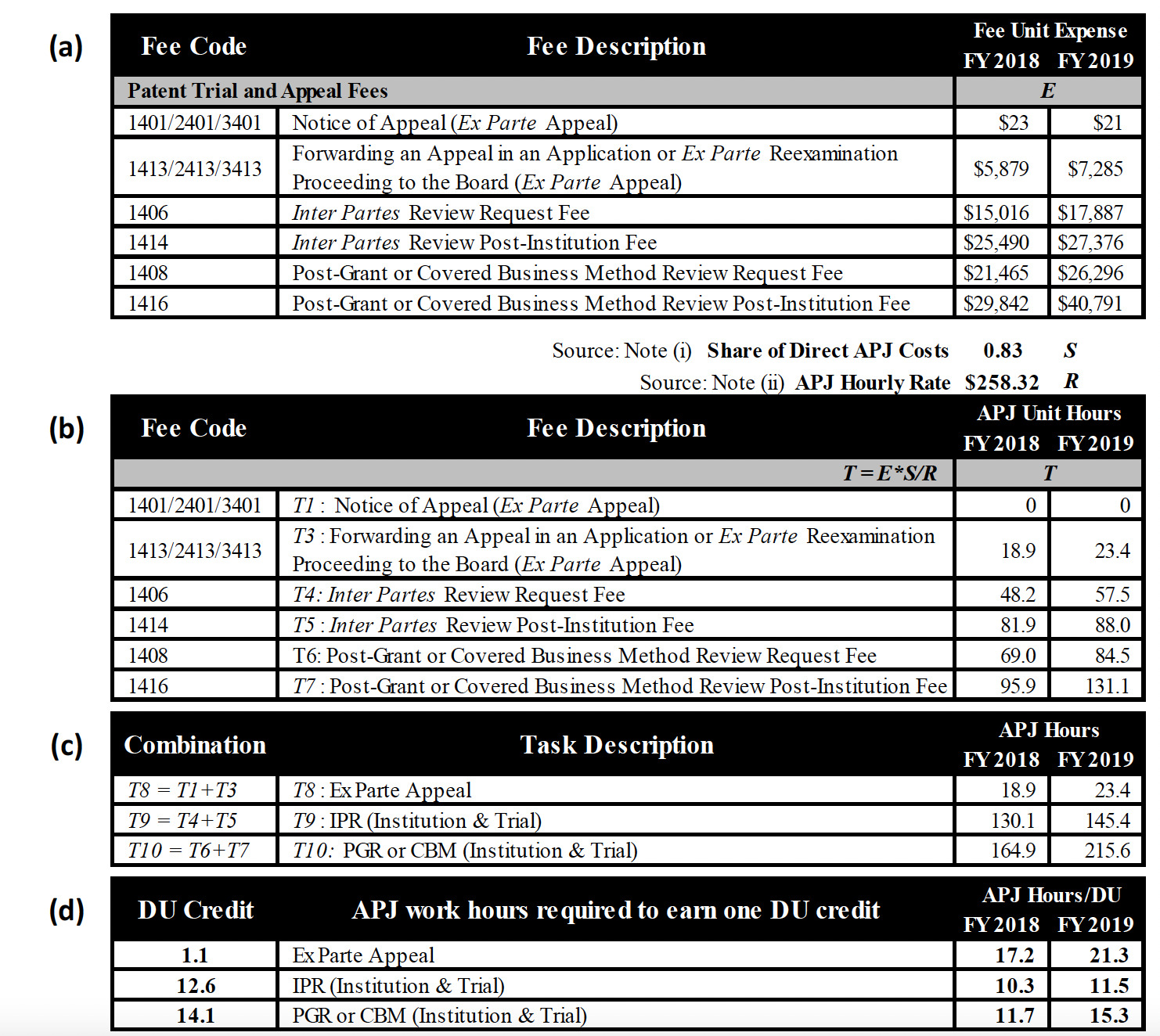
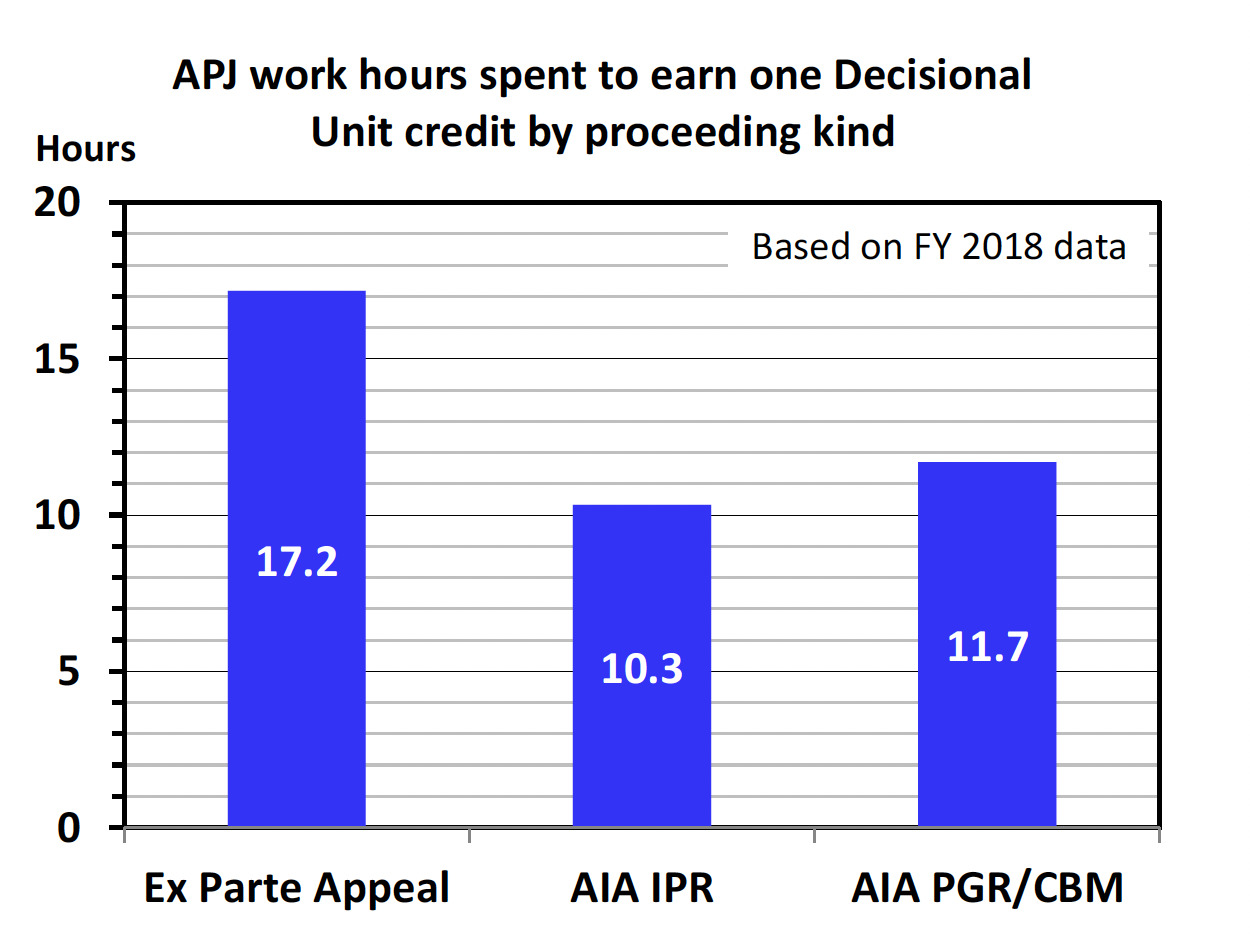
Leadership is Incentivized to Favor AIA Trials Too
Furthermore, the APJs must seek permission from PTAB leadership who “have presumptive pecuniary interest in denying permission,” according to Katznelson. The July 2021 study showed that senior PTAB official’s performance plans “contain critical element goals that require maintaining AIA trial completion in 12 months and issuance of institution decision within [the] statutory period of 3 months, and further requiring them to ‘[e]nsure PTAB employees are efficiently working on mission-critical tasks.’” Katznelson said this shows the leadership interests are in ensuring that APJs are focused on AIA proceedings and “are not distracted by extraneous appeals work that could undermine their ability to meet the statutory deadlines on AIA trial work already in progress.”
While there is an incentive for senior PTAB officials to reduce the backlog of ex parte appeals, the language used in their performance plans qualifies this goal as being “within limits imposed by AIA trial inventory and deadlines.” This puts AIA trials first, causing PTAB leadership “to protect the resources required to institute and adjudicate AIA trials at the expense of delaying ex parte appeal decisions if necessary, which have no statutory completion deadline.” Ultimately, said Katznelson, “the PTO cannot control or increase the number of ex parte appeals which are driven by patent applicants and thus those proceedings have no use in increasing PTAB revenues and workload.”
Image Source: Deposit Photos
Image ID:329066836
Copyright:firebrand3

![[IPWatchdog Logo]](https://ipwatchdog.com/wp-content/themes/IPWatchdog%20-%202023/assets/images/temp/logo-small@2x.png)

![[Advertisement]](https://ipwatchdog.com/wp-content/uploads/2024/04/Patent-Litigation-Masters-2024-sidebar-early-bird-ends-Apr-21-last-chance-700x500-1.jpg)

![[Advertisement]](https://ipwatchdog.com/wp-content/uploads/2021/12/WEBINAR-336-x-280-px.png)
![[Advertisement]](https://ipwatchdog.com/wp-content/uploads/2021/12/2021-Patent-Practice-on-Demand-recorded-Feb-2021-336-x-280.jpg)
![[Advertisement]](https://ipwatchdog.com/wp-content/uploads/2021/12/Ad-4-The-Invent-Patent-System™.png)







Join the Discussion
24 comments so far.
B
September 19, 2022 10:23 am@ Anon ” I know – who would think that legislating from the Bench would
reach out to affect patent law.”
It’s not just that these clowns don’t understand basic constitutional seperation of powers; it’s that that their holding are incredibly destructive.
Anon
September 19, 2022 10:16 amThank you Ron.
Even more so (in light of Ron’s points), the decision to move data into the shadows is disturbing given the need to avoid the appearance of impropriety.
A further wrinkle (for Admin Law aficionados) is that even** the Supreme Court is (again) writing (or re-writing) law from the bench by materially changing structure as written by Congress in the Arthrex case to ADD “control” over so-called ‘neutral arbiters’ of a non-Article III ‘Judicial’ body already in a clearly ‘political’ Branch*** of the government.
** I know – who would think that legislating from the Bench would reach out to affect patent law [/S]
*** as if Oil States had not done enough damage to the notion of a secured bundle of personal property rights; let’s add more ‘power in the shadows’ in the branch of the government ALREADY deeply infested with Deep State machinations.
Ron Katznelson
September 18, 2022 02:40 pmAnon,
As to your question below, under the “public-domain doctrine, materials normally immunized from disclosure under FOIA lose their protective cloak once disclosed and preserved in a permanent public record.” Cottone v. Reno, 193 F.3d 550, 554, (D.C. Cir. 1999). The annual bonus award information for all APJs was made public by official government disclosure in OPM’s release of the Enterprise Human Resources Integration-Statistical Data Mart (EHRI-SDM) dataset, which FederalPay.org “disclosed and preserved in a permanent public record” for at least 3 years.
The question that remains for legal research is what constitutes “permanent record” given that the decision in Cottone was aimed at preventing the government from relying on clawbacks of information already released to the public.
In any event, bonus awards of government employees are not “normally immunized from disclosure under FOIA” and should be disclosed when requested. Civil Service regulations specifically require that information on “performance awards or bonuses” amounts must be made “available to the public.” 5 C.F.R. § 293.311(a)(4). See also FLRA v. U.S. Dep’t of Commerce, 962 F.2d 1055, 1060 (distinguishing personnel “ratings,” which traditionally have not been disclosed, from “performance awards,” which ordinarily are disclosed).
Anon
September 18, 2022 10:51 amGeneral question for those conversant with administrative law:
Is there a requirement to “show cause” (to borrow the parlance) for an Administrative Agency to “change its mind” and redact what had already been made public?
This strikes me of the adage that wrong doing is bad enough, but when cover-up is pursued, real malfeasance is present. (think of the actual impact of Watergate, as it was less the original clandestine actions and more the “higher-up” follow-on actions that drove the ‘real’ action).
jeffswaterworks
September 16, 2022 02:35 pmAgain, I appreciate all the help. Now, does anybody know if there is a compendium of PTAB judges and their percentage of cancellations?
jeffswaterworks
September 16, 2022 01:50 pmPerfect! Thank you, Ron. And you too MD.
B
September 16, 2022 01:48 pm@Ron, JeffsWW et Al.
You guys impress me with your efforts
Ron Katznelson
September 16, 2022 01:40 pmjeffswaterworks
Your observations are correct. What you see is the result of pressure on Federalpay.org that was apparently exerted after my article was published in July 2021, to remove the bonus information from their site.
Fortunately, another organization has kept a copy of all that APJ compensation data before it was removed from Federalpay.org and posted it at http://www.fairinventing.org/documents . The data can be downloaded in the item titled:
2. APJ Compensation Data (2012-2019) (compiled from federalpay.org).xlsx, which contains a tab for each year.
I hope this helps.
jeffswaterworks
September 16, 2022 08:59 amThis is what I see for Paulraj on the link you gave me, I’m not really interested in Paulraj he is just an example:
Year Occupation Paygrade Base Salary Bonus Location
2021 Patent Attorney AD-00 $183,300 $0 Alexandria, Virginia
2020 Patent Attorney AD-00 $181,500 $0 Alexandria, Virginia
2019 Patent Attorney AD-00 $176,900 $0 Alexandria, Virginia
2018 Patent Attorney AD-00 $174,500 $0 Alexandria, Virginia
2017 Patent Attorney AD-00 $172,100 $0 Alexandria, Virginia
mdhoyle
September 16, 2022 08:44 amJeffWaterWorks
CHRISTOPHER G. PAULRAJ
Year Salary Bonus
2014 $167,000.00 $-
2015 $168,700.00 $27,691.00
2016 $170,400.00 $33,066.00
2017 $172,100.00 $16,273.00
2018 $172,100.00 $16,273.00
jeffswaterworks
September 15, 2022 10:37 pmMD,
When I go to that site and search for Judge Paulraj (one of the judges listed on Ron’s link) it shows a salary and no bonus for 2015-18. Compare that to Ron’s link which shows him with a five digit bonus for all of those years. Am I not looking in the right spot??? TIA!!
jeffswaterworks
September 15, 2022 04:01 pmCaptain Obvious, the IPRs I’m interested in were instituted in Oct. 2015, so the question still stands.
Ron Katznelson
September 15, 2022 03:42 pmCapt. Obvious,
Your contention that APJ bonuses were ended in 2016 is “Obviously” wrong. For example, two of the APJs in the New Vision case discussed in this article received large bonuses in 2018, for the same year they considered the petition and instituted the trial on New Vision’s patent.
See https://usinventor.org/wp-content/uploads/US-Inventor-FOIA-Appeal-on-F-21-00090-May-25-2021.pdf#page=11
mdhoyle
September 15, 2022 02:27 pmjeffswaterworks
If you search with the Judges name, this site will provide each year the salary and bonus. And in response to Capt. Obvious, who is totally devoid of facts, the PTAB bonus program was still very much alive as late as 2019. The PTO admitted such at the CAFC and acknowledged the cap “then” was $10,000. Their defense was “that’s such a small amount it has no significance.” I have no clue as to the “cap” today and the PTO refuses to admit.
B
September 15, 2022 12:46 pm@ Capt. Obvious “Bonuses were ended in 2016. More foolish hysteria from the troll bar.”
Law360 had an article about PTAB bonuses last year. The bonus for rejecting a claim being almost $400, the bonus for an honest decision being $2. Also there’s this article from IPWatchdog from last year. https://ipwatchdog.com/2021/10/13/cafc-shoots-due-process-challenge-ptab-structure/id=138744/
Not saying you’re wrong. I’m just saying I don’t know
B
September 15, 2022 11:45 am@ I am going through “a” process, not due process, when evidence does not matter and rejection statements appeared illogical on the surface”
The PTAB and CAFC both OUTRIGHT REFUSED to address the evidence issue, and REFUSED to address controlling SCOTUS precedent.
B
September 15, 2022 11:41 am@ Pro Say “Given all that we now know about it, the PTAB is (pick any three): 1. A den of thieves. . . . .”
I once had a PTAB panel OUTRIGHT LIE in an opinion stating that I had made deceptive comments. This was in an opinion in which the PTAB Panel OUTRIGHT LIED about another issue.
I called the Virginia Bar for advice – then contacted the Chief APJ – then demanded a retraction on an RFR. The PTAB Panel did make a “clarification” on rehearing in a most bone-headed, idiotic statement that made zero sense.
However, not all APJs are such sleazeballs. In fact, there are a lot of good ones I respect quite a bit.
Now, the question is: how does one address this same issue if the CAFC does it?
Capt. Obvious
September 15, 2022 10:50 amBonuses were ended in 2016.
More foolish hysteria from the troll bar.
jeffswaterworks
September 15, 2022 10:08 amThank you, MD. And do you know how we can tell how much of a bonus they received in each year? I appreciate your help.
mdhoyle
September 15, 2022 09:24 amjeff
if you know the judges name, here is the site via the OPM that will provide the details. This is only good through 2018. In 2019, the PTO began to hide their pay and bonus. Under Iancu, the cap was $10,000 annually. Who knows what it is today?
https://www.federalpay.org/employees
jeffswaterworks
September 15, 2022 08:59 amIs there any place where the judges’ bonuses are listed on an individual basis?
Anon
September 15, 2022 08:31 amOn that ‘other blog,’ there is currently an ‘Academic’ piece taking the opposite stance in regards to the “power of the administrative state” (and the related Soviet telephone Justice) — espousing that “dial up the Ends desired capability that the [captured] AIA provides.
concerned
September 15, 2022 06:18 am“but a bonus hand made up of cards from a plurality of independent hands is an inventive concept”
I thought my process of using new data never gathered in my field or any known field of commence to solve a long term problem was an inventive concept. Suppose a person gathers new data and it solves a horrible disease, patent? Are results secondary to impressing the robes with means?
I am going through “a” process, not due process, when evidence does not matter and rejection statements appeared illogical on the surface. When “special” terms are not defined by the courts or USPTO, especially after advising the everyday meaning of the words are not acceptable, it seems to be a violation of due process.
My “bonus” hand was a collection of case law that conflicted with other case law, dealer’s choice literally. The “House” always wins as I am advised that a s101 rejection has never been overturned by the CAFC.
Good luck with your “due process” arguments.
Pro Say
September 14, 2022 06:31 pmGiven all that we now know about it, the PTAB is (pick any three):
1. A den of thieves.
2. A slice of lemmings.
3. A gaggle of stooges.